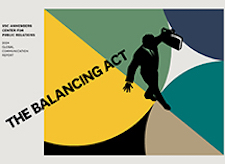 Ryan Barr Ryan Barr |
As communicators, we’ve written countless mission, vision and purpose statements in an effort to differentiate companies in the market and develop a guiding light for their decision-making. These values have become the cornerstone of corporate narratives and the foundation of communications programs for decades. In today’s world, it’s not enough to simply put words to paper. Companies must act more human. Companies need to take a stance on issues that connect with all their stakeholders. Companies can and should have a positive, lasting impact on society.
Whether you call it Stakeholder Capitalism, ESG, CSR or countless other terms, it’s about doing better for all, not just a few. Business leaders have begun to adopt this philosophy and we’ve seen it play out in a variety of ways from carbon offsetting to stances on human rights to community reinvestment. However, at the end of the day, it’s simply the soul of a company.
The challenge facing executives and, ultimately, communicators, is: How do you balance the needs of so many different stakeholders that often can’t see the forest through the trees? Consumers want to get the best product from companies. Investors want to maximize shareholder value. Employees want to thrive within an organization. Communities want to trust their corporate neighbors. Meeting all these needs can be challenging as it’s often difficult to see the intersection of diverging points. But if we accept the notion that companies are more than just profit centers, job creators or product manufacturers, we can see a path forward that creates lasting brand loyalty and investor affinity.
| This article is featured in O'Dwyer's Aug. Financial PR/IR & Professional Services PR Magazine (view PDF version) |
Let’s first look at investor sentiment as it relates to stakeholder capitalism. Any investment rationale starts with the concept of maximizing shareholder value. It’s a simplistic and often myopic point of view. Some believe that a company must do what is best for its bottom line and if anything varies from delivering maximum profitability it should be terminated. Marketers and communicators know this isn’t true. How do they know? Sales teams constantly ask for new ways to engage consumers and create deeper, more meaningful connections that differentiate their brand in the market. This, in turn, sparks increased brand loyalty, driving revenue growth and profitability. To make this happen, companies must invest in consumer relationships and not just put out superior products. According to a recent Gartner report, the benefits of investing in ESG goes beyond Wall Street. Companies that invest in ESG-driven activities more easily access capital, increase shareholder value, experience cost savings and create superior brand loyalty. Additionally, companies that invest in ESG also report higher levels of employee satisfaction, retention and recruitment.
In today’s global marketplace, with thousands of options available to consumers, brand loyalty is earned through the actions of companies. Consumers want to feel good about the brands they buy and not just the products. According to a PwC survey, 76 percent of consumers say they’ll stop buying from companies that treat the environment, employees or the community in which they operate poorly. Microsoft is globally recognized as one of the most influential and successful brands in the world. And according to The Motley Fool’s ESG Compounder Checklist, Microsoft might not be perfect, but it did score a nine out of 10 while ranking as the third most valuable company in the world. Even small businesses recognize the power of social responsibility. Would Bombas sell as many socks if they didn’t donate a pair to a homeless shelter for every pair purchased? These purpose-driven initiatives deliver on so many levels and do not sacrifice profits. In fact, they increase loyalty and drive bottom-line results.
It’s not just investors and consumers that companies need to focus on. Employees are the greatest asset of any organization and the scarcest in today’s new workplace. Companies are competing for talent across industries and geographies as the traditional workforce becomes blurred. Like other stakeholders, employees want to feel good about the company they work for and hold more power in the relationship than ever before. Employee engagement is critical to a company’s success. According to a recent Gallup Poll, companies with high levels of employee engagement see an 18 percent boost in productivity, 43 percent less turnover and 23 percent higher profitability.
All of this creates opportunities for communications professionals. Business leaders are relying on communications more than ever. Like many senior roles within an organization, the evolution of communications has been profound over the past decade and accelerated during the pandemic. Communicators need to engage multiple stakeholders, address ESG issues, navigate volatile market conditions and motivate a mostly virtual workforce. This all starts and ends with the corporate narrative. One that embraces an inclusive storyline that builds affinity and loyalty. One that takes advantage of new channels of communication that engage stakeholders where they are and how they want to consume content. And, most importantly, one that bares the soul of the company in a transparent and genuine tone that demonstrates a company’s commitment to doing better.
If you want to truly add value to your company or clients, be the agent of change. Challenge companies to do better and communicate with all stakeholders. Celebrate brands that are making the world a better place. Build brand loyalty through action and be rewarded for doing the right thing.
***
Ryan Barr is Managing Partner, Global Financial Services Practice Leader, at Finn Partners.


 A growing number of consumers, company employees and even PR professionals now think companies should dial back on ESG initiatives, according to the latest Global Communications Report from USC Annenberg.
A growing number of consumers, company employees and even PR professionals now think companies should dial back on ESG initiatives, according to the latest Global Communications Report from USC Annenberg. Shareholders filed a record 535 environmental, social and governance resolutions for the upcoming proxy season, according to a report by As You Sow, Sustainable Investments Institute and Proxy Impact.
Shareholders filed a record 535 environmental, social and governance resolutions for the upcoming proxy season, according to a report by As You Sow, Sustainable Investments Institute and Proxy Impact. Americans agree that companies play a role in addressing some of the major social and political challenges facing our world today, but a stark partisan divide arises when it comes to what issues the private sector should try to solve—and how they do it.
Americans agree that companies play a role in addressing some of the major social and political challenges facing our world today, but a stark partisan divide arises when it comes to what issues the private sector should try to solve—and how they do it. Teneo has tapped Pia Heidenmark Cook, former chief sustainability officer for IKEA, as a senior advisor in its London office.
Teneo has tapped Pia Heidenmark Cook, former chief sustainability officer for IKEA, as a senior advisor in its London office. Arielle Gross Samuels, global head of environmental, social and governance activity at Mark Zuckerberg’s Meta, is joining Blackstone, the world’s largest alternative asset manager and commercial real estate owner.
Arielle Gross Samuels, global head of environmental, social and governance activity at Mark Zuckerberg’s Meta, is joining Blackstone, the world’s largest alternative asset manager and commercial real estate owner.


 Have a comment? Send it to
Have a comment? Send it to 
No comments have been submitted for this story yet.